A no man’s land turned into a natural reserve ?
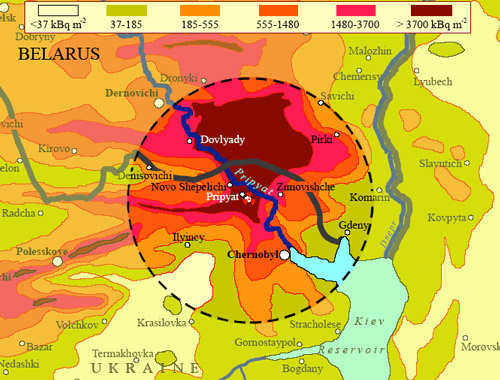
An evacuated zone 30 km around the reactor
This map of radioactive deposits (measured by activity of cesium-137 in soil), in the immediate vicinity of the damaged reactor at Chernobyl, shows very high contaminations but very uneven. Activity exceeds 3700 kBq per square meter near the reactor and the city of Pripyat (40 times the dose rate of natural radioactivity). These contaminations have led, on April 27, 1986, to the evacuation by the Soviet authorities of 116,000 people living within a circle of 30 km radius.
UNSCEAR-2000
On April 27th, 1986, one day after the explosion, the Soviet authorities proceeded to the evacuation of 116,000 residents living within 30 km around the damaged plant. The area was evacuated in emergency within 30 hours and declared prohibited. The exclusion zone has since remained largely uninhabited, though defying the proscriptions, about 500 people, usually elderly, the « samosjoly » returned to live there, preferring not to leave the villages and the environments to which they were attached.
If one adds to these 116,000 inhabitants, people outside the zone who were also evacuated later, it is a total of some 350,000 people who had to suffer the trauma of uprooting imposed overnight and relocation.
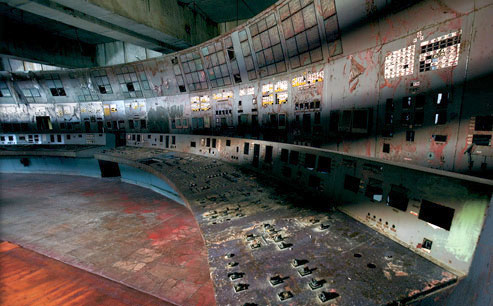
The abandoned control room
In the centre of the exclusion area, the abandoned reactor and the control room. Mike Durst, a nuclear physicist at the IAEA: « Inside, you feel like in a tomb. Cold, wet and dark. Pipes burst, a lot of debris. You are going all over a series of mazes to reach the control room where operators controlled the reactor. The level of radiation is not too high, but if you go down below it is mortal «
NGM (The long shadow of Chernobyl)
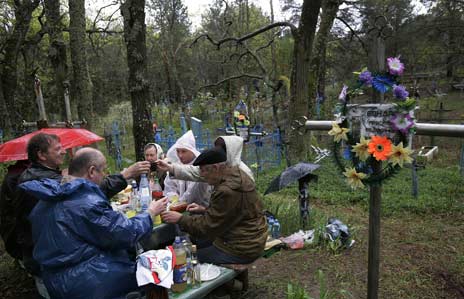
Brief return to honor the deads
Former residents of the zone raise their glasses to the memory of their deads. The authorities allow evacuees to return once a year, each spring, to visit the graves and honor the memory of their disappeared relatives and ancestors during a « Day of the parents ». To melancholy of memory, another dimension is added ; families commemorate not only their families but also a way of life lost.
© NGM / Gerd Ludwig
In the centre of the exclusion area one can see the damaged unit covered by its sarcophagus, the other three units that operated until 2000, and at about two kilometers, the ghost town of Pripyat of which many of the 50,000 residents were employed at the plant.
Man having left, an animal kingdom has taken its place. This vast no-man’s land of nearly 3000 km2 has become, in twenty years, a reserve abounding with life and full of species that now prevail. Elk, deer, wild boars have multiplied, and after them wolfves and hundreds of bird species. Lynxes or owls that were not been seen for decades have reappeared. The footprints of a bear have even been identified, an animal that had not set foot in this part of Ukraine for centuries.
According to an Ukrainian radioecologist, Sergey Gaschak, interviewed by the BBC, the animals occupy their territories regardless of radiations they do not feel: “There may be plutonium in the area, but there is no herbicide or pesticide, industry, traffic. Marshes are not dried up … Many birds nest in the sarcophagus, starlings, pigeons, swallows, red-tails. I have seen nests and I found eggs. »
However, this paradoxical paradise was not so idyllic when radiation levels were much higher during the first weeks after the accident. In the red forest, close to the reactor, 4 km2 of pine became red and brown just died. In the most radioactive places, animals died or stopped reproducing.
Since, the most active but short-lived radioelements have disappeared and the radioactivity much decreased. Nature and animals have adapted to these milder conditions. When observzd, DNA mutations seems to have not affected the physiology of the animal or its ability to reproduce.
have disappeared and the radioactivity much decreased. Nature and animals have adapted to these milder conditions. When observzd, DNA mutations seems to have not affected the physiology of the animal or its ability to reproduce.
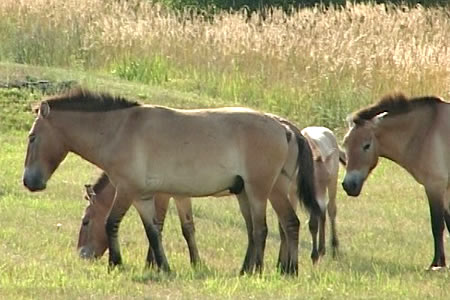
Przewalski horses
The exclusion zone is full of wild animals. The human presence being banned, the area, spanning Ukraine and Belarus, became a sanctuary for animals. It is used for the resettlement programs of endangered species, like the Mongolian wild horse, the Przewalski horses.
© IAEA / Kirstie Hansen (A chernobyl diary)
Large animals such as deer or elk, which travel long distances, in and out of heavily contaminated land without staying a long time, are less exposed than small animals that may be confined in these places for life. But there are signs that these little creatures adapt to circumstances. Sergey Gaschak found that mice living among the stunted and deformed pines in the « red forest » lived as long as those living on cleaner land, but that the later resisted with difficulties to a transplantation in the contaminated environment of this forest.
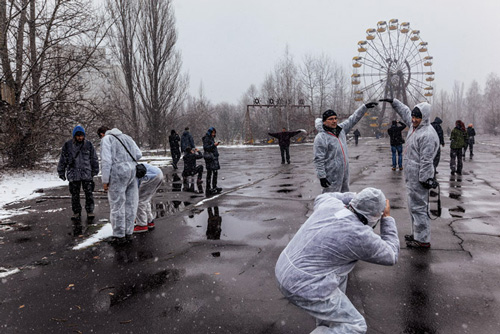
Nuclear tourists in Prypiat
The Prypiat recreational park should have opened onMay 1st 1986, but the plant exploded five days before. Now, it offers to tourists an attraction of a new type.
© Gerd Ludwig : National Geographic Magazin/
In 2014, after many years and owing to many decontamination efforts, an interesting article in the National Geographic Magazine reports of an early nuclear tourism. After the wildlife that has reclaimed the quasi uninhabited area, tourists of a new kind turn in. They take pictures of themselves in the amusement park of the Pripyat ghost town, wearing no masks but avoiding to picki up mushrooms
Other articles on the subject « Chernobyl accident »
Chernobyl Circumstances
An explosion followed by a graphite fire In 1986 the Ukrainian Chernobyl plant had 4 RBMK reactor[...]
Chernobyl Liquidators
A heavy toll paid by firefighters and liquidators: The magnitude of the disaster took the Soviet [...]
Radioactive Releases
Radioactive releases and contaminations at Chernobyl The explosion of the reactor led to the disp[...]
Chernobyl Plume
A deep mark in the french collective unconscious « The Chernobyl cloud has stopped at the french [...]
Chernobyl Health Effects
Chernobyl: A toll still impossible to quantify It is difficult to reach an approached assessment [...]
Chernobyl Iodine 131
A dangerous radioelement during the first weeks Iodine-131 is the most feared fission product whe[...]
Chernobyl Caesium-137
The accident long term legacy More than twenty years after the Chernobyl accident, attention focu[...]
Chernobyl Today
The Chernobyl Site Over 30 Years Later On December 15, 2000, the Ukrainian government, in accorda[...]